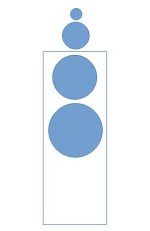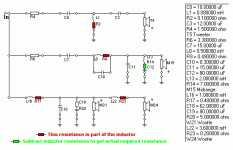For several years I wanted to build loudspeakers based on the Falcon like Baffleless Concept Speaker designed by AmpsLab (Falcon, Falcon II, Falcon III). I recently sold my Klipsch Tangent 400, so there's an opportunity to build something new. Initially, I wanted to base the project on a Dayton RS52AN dome, but a friend convinced me that Visaton G 50 FFL would be better (easier to apply). As a partner for the G50FFL, I wanted the largest possible woofer (12" or 10"), but in turn, colleagues from this forum convinced me that a maximum of 8" woofer would be better. I chose the Visaton W200S (nice woofer good for 2-way also, 8" is good for cross with mid dome @ 800Hz, better for directivity match, should be quick enough). To help with baffle step correction and lower extension I decided to add 0.5 way and a second woofer - Visaton W250S in parallel. Lower woofer will be vented and upper woofer will closed (like in Tony Gee's speakers).
I need your help to make this concept work.
1. Is it the crossover concept from Zaph ZDT3.5 good for me (I mean the way woofers are connet in parallel)?
2. What tweeter will You recommend for Visaton G 50 FFL - crossed @ 3,5KHz (or so). I think small tweeter will be better for directivity match and closer sound center of both domes. My type is SB Acoustics SB21SDCN. Any better small tweeter for up to 50 Euro/pc?
3. Cabinet - high 90cm, 32-35cm wide and 30-32cm deep. Is it better make wider (lower frequency baffle step correction) or narrowest possible?
4. Should both woofers be as high as possible?
Visaton W250S, W200S and G 50 FFL I already have.
Thanks in advance for advice.
I need your help to make this concept work.
1. Is it the crossover concept from Zaph ZDT3.5 good for me (I mean the way woofers are connet in parallel)?
2. What tweeter will You recommend for Visaton G 50 FFL - crossed @ 3,5KHz (or so). I think small tweeter will be better for directivity match and closer sound center of both domes. My type is SB Acoustics SB21SDCN. Any better small tweeter for up to 50 Euro/pc?
3. Cabinet - high 90cm, 32-35cm wide and 30-32cm deep. Is it better make wider (lower frequency baffle step correction) or narrowest possible?
4. Should both woofers be as high as possible?
Visaton W250S, W200S and G 50 FFL I already have.
Thanks in advance for advice.
Attachments
Last edited:
Do what makes you feel good. There are good reasons why the differences between driver size 'should' be kept to a minimum, but I think many 10" or 12" drivers can be pushed to 1kHz or so to meet the dome midrange you've set your sights on.
One thing you could try is to use a high sensitivity woofer and pad it down with series resistance. I've had good results with that little trick in clearing up the midrange beyond expectations. But of course it depends on how loud you want to go, and how/if you want to factor in the added resistance at the design stage. If you have tubes or a class-A amplifier with high output resistance then that will also change things up. The SB Audience 'Bianco' woofers could be nice?
I'm not sure about the bass part of the XO design you posted. I wouldn't connect 2 (different) woofers on the same 'wing' simply because they are distortion and voltage generators. So if the amplifier has low output resistance, I would use that and put W21 and W24 on separate sections. Re: passive crossovers, I would build them up iteratively. E.g.:
Tweeter: Rpad + cap
Mid: L+C (+R?)
Bass: L + Rseries (discussed above)
Something doesn't sound quite right? Home-in on it. Experiment. Last resort: increase filter order. This is a bit different from spending lots of time simulating and attempting to build only once (I'm guilty of that, too).
I missed a detail about the baffle-less part: is the mid going to be open backed as well? AFAICT, it's still important to take care of diffraction. E.g. a small teardrop shape, or ball-shaped enclosure is surely going to be better than a boxy shape. Horn principles always apply, even if the throat angle starts at 180 degrees.
A wide glass frame could be another idea, for the mid and tweet. But if you want a more omni sound, then matching with woofers gets trickier. A pair of identical woofers could be horizontally opposed for the forces to cancel out.
One thing you could try is to use a high sensitivity woofer and pad it down with series resistance. I've had good results with that little trick in clearing up the midrange beyond expectations. But of course it depends on how loud you want to go, and how/if you want to factor in the added resistance at the design stage. If you have tubes or a class-A amplifier with high output resistance then that will also change things up. The SB Audience 'Bianco' woofers could be nice?
I'm not sure about the bass part of the XO design you posted. I wouldn't connect 2 (different) woofers on the same 'wing' simply because they are distortion and voltage generators. So if the amplifier has low output resistance, I would use that and put W21 and W24 on separate sections. Re: passive crossovers, I would build them up iteratively. E.g.:
Tweeter: Rpad + cap
Mid: L+C (+R?)
Bass: L + Rseries (discussed above)
Something doesn't sound quite right? Home-in on it. Experiment. Last resort: increase filter order. This is a bit different from spending lots of time simulating and attempting to build only once (I'm guilty of that, too).
I missed a detail about the baffle-less part: is the mid going to be open backed as well? AFAICT, it's still important to take care of diffraction. E.g. a small teardrop shape, or ball-shaped enclosure is surely going to be better than a boxy shape. Horn principles always apply, even if the throat angle starts at 180 degrees.
A wide glass frame could be another idea, for the mid and tweet. But if you want a more omni sound, then matching with woofers gets trickier. A pair of identical woofers could be horizontally opposed for the forces to cancel out.
Last edited:
Nice project. Similar to my recent one .
https://www.diyaudio.com/community/threads/3-way-sealed-bass-ob-dipole-mid-hi.398072/
Maybe having the 8" lower will mitigate the floor bounce. I do wonder about adding another RS225 to my 'bass modules'.
https://www.diyaudio.com/community/threads/3-way-sealed-bass-ob-dipole-mid-hi.398072/
Maybe having the 8" lower will mitigate the floor bounce. I do wonder about adding another RS225 to my 'bass modules'.


